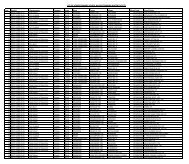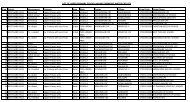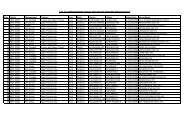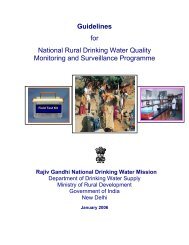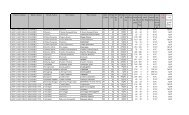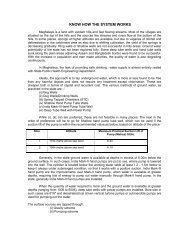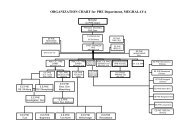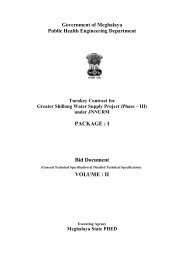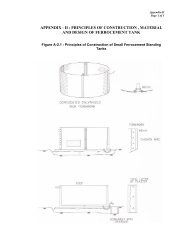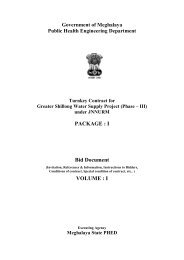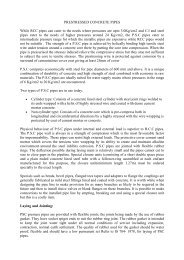BACKGROUND OF WATER SUPPLY PROGRAMME ...
BACKGROUND OF WATER SUPPLY PROGRAMME ...
BACKGROUND OF WATER SUPPLY PROGRAMME ...
Create successful ePaper yourself
Turn your PDF publications into a flip-book with our unique Google optimized e-Paper software.
<strong>BACKGROUND</strong> <strong>OF</strong> <strong>WATER</strong> <strong>SUPPLY</strong> <strong>PROGRAMME</strong><br />
INTRODUCTION<br />
When India achieved freedom, organised water supply was restricted to larger<br />
towns/cities only, but that too was inadequate. The rural population which constitutes approx 80%<br />
of the total population was without any safe drinking water supply. Water supply at that time was<br />
a provincial or a state subject and the State Governments were independently pursuing their own<br />
programme to a limited extent, depending on their financial resources.<br />
The Bhore Committee (1946) and the Environmental Committee (1949) recommended<br />
comprehensive plans to provide water supply and sanitation on a priority basis. No concerted<br />
efforts could be taken to implement the recommendation. In the year 1954, The Government of<br />
India provided assistance to the states to establish special investigation divisions in the fourth<br />
Five Year Plan to carry out identification of the problem villages. A 'problem' village was defined<br />
as one where no source of safe water is available, within a distance of 1.6 km or where is<br />
available at a depth more than 15 metres or water source has excess salinity, iron, fluorides and<br />
other toxic materials or where water is exposed to the risk of Cholera or Guinea Worm. Taking<br />
into account the magnitude of the problem and to accelerate the pace of coverage of problem<br />
villages, the Central Government introduced the Accelerated Rural Water Supply Programme<br />
(ARWSP) in 1972-73 to assist the states and the Union territories with 100% grants in aid to<br />
implement the schemes in such villages. This programme continued till 1973-74. But with the<br />
introduction of the Minimum Needs Programme (MNP) during the fifth five year plan (From 1974-<br />
75), it was withdrawn. The Programme was however, reintroduced in 1977-78 when the progress<br />
of supply of safe drinking water to identified problem villages under MNP was not found to be<br />
focusing enough on the problem villages.<br />
The Minimum Needs Programme (MNP) was introduced with the objective to provide<br />
certain basic minimum needs and thereby to improve the living standards of the people.-It was<br />
the expression of commitment of the Govt. for the social and economic development of the<br />
community. The programme apart from others included rural water supply. It was decided in the<br />
30th World Health Assembly of WHO in 1977 to launch a movement known as "Health For All By<br />
The Year 2000" for" attainment of level of Health, that will enable every individual to lead a<br />
socially and an economically productive life. "In 1978, the Alma Ata International Conference on<br />
Primary Health are reaffirmed health for all as the major social goal of the governments and<br />
called up on all the governments to formulate national policies, strategies and plans of action to<br />
achieve the objective. In 1981, a global strategy for "HFA" was evolved by WHO. The" Govt. of<br />
India also launched the "INTERNATIONAL <strong>WATER</strong> <strong>SUPPLY</strong> AND SANITATION DECADE (81-<br />
90) <strong>PROGRAMME</strong>" in 1981 with a target of :<br />
(i) 100% coverage of rural and urban population with safe drinking water supply facilities;<br />
(ii) 80% coverage of urban population with sanitation;<br />
(iii) 25% coverage of rural population with sanitation; by 1990.<br />
To supplement the effort of the State Govt. in providing drinking water, Technology<br />
Mission for drinking water [TM] was set up in 1986 by Govt. of India to establish area based Mini<br />
Mission Projects for \. sustainable supply of safe drinking water and to establish Sub-Mission of<br />
scientific source finding of water, control of Flurosis, eradication of Guinea Worm, removal of<br />
excess iron and control of brackishness. In 1991, TM was renamed as Rajiv Gandhi National<br />
Drinking Water Mission [RGNDWM] with the broad objective of providing sustainable safe<br />
drinking water to all uncovered/no source villages and creating awareness among the rural<br />
people about the hazards of using unsafe water.<br />
In order to give focused attention towards attaining the goal of providing safe drinking<br />
water to all rural habitations in the next five years in consonance with the National Agenda for<br />
Governance of the Government, the Department of Drinking Water Supply has been created in<br />
the Ministry of Rural Development in October 1999.<br />
During the year 1991-92, a field survey was conducted all over the country to ascertain<br />
the status of water supply in the habitations, as per the directives of Govt. of India. According to
the survey, a village is generally made up of 'Main Habitation' and 'Other Habitation'. The<br />
definitions are as follows:<br />
Main Habitation: - Is the part of the village having major facilities like school, market, health<br />
centre, post office etc.<br />
Other Habitation: - Are the hamlets/areas surrounding the main habitation.<br />
OBJECTIVE<br />
The prime objectives of the Mission are:-<br />
• "to ensure coverage of all rural habitations especially to reach the un- reached with<br />
access to safe drinking water;<br />
• to ensure Sustainability of the systems and sources; and<br />
• to tackle the problem of water quality in affected habitations and to preserve quality of<br />
water by institutionalising water quality monitoring and surveillance through a Catchment<br />
Area Approach.<br />
NORMS<br />
The following norms are being adopted for providing safe drinking water to rural population in the<br />
habitations:<br />
• 40 liters of safe drinking water per capita per day (lpcd) for human beings.<br />
• 30 lpcd additional for cattle in the Desert Development Programme Areas.<br />
• One hand-pump or stand post for every 250 persons.<br />
• The water source should exist within the habitation / within 1.6 km in the plains and within<br />
100 Mts. elevation in the hilly areas.



